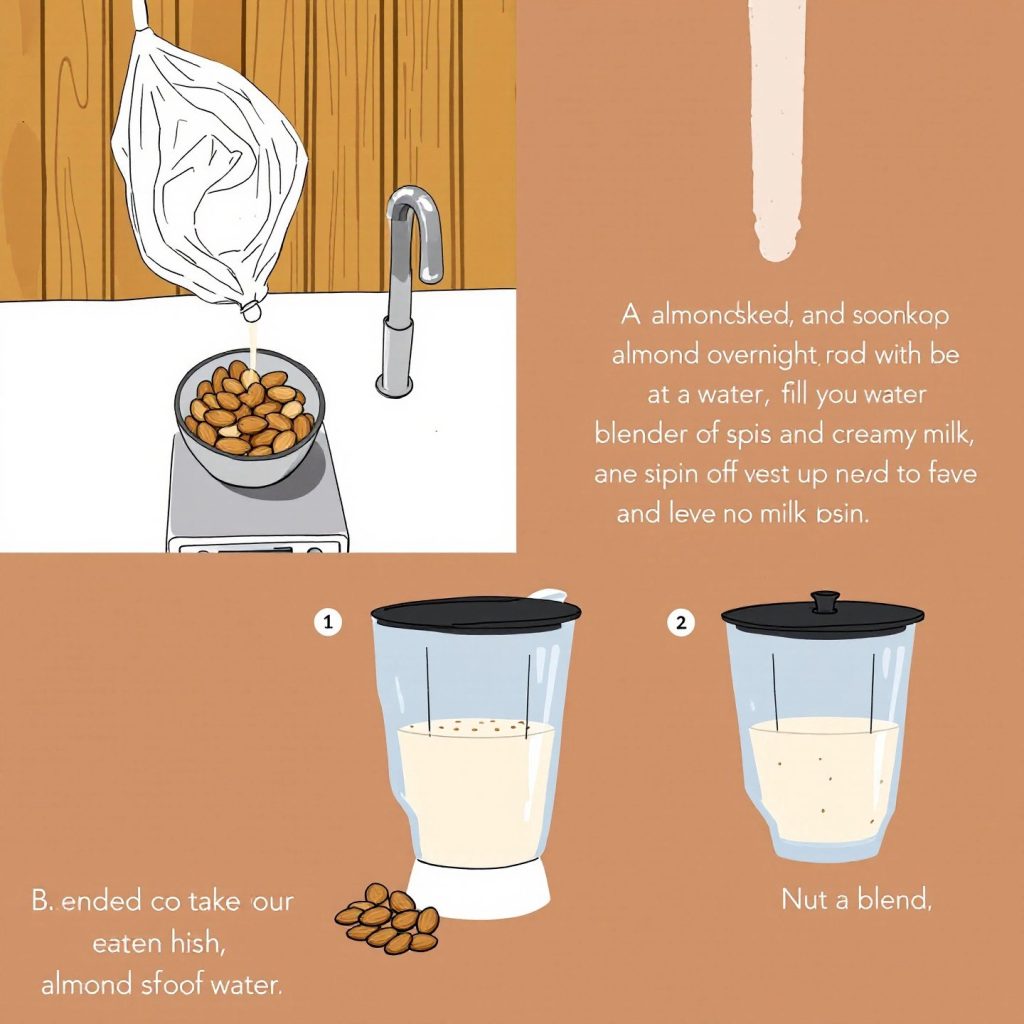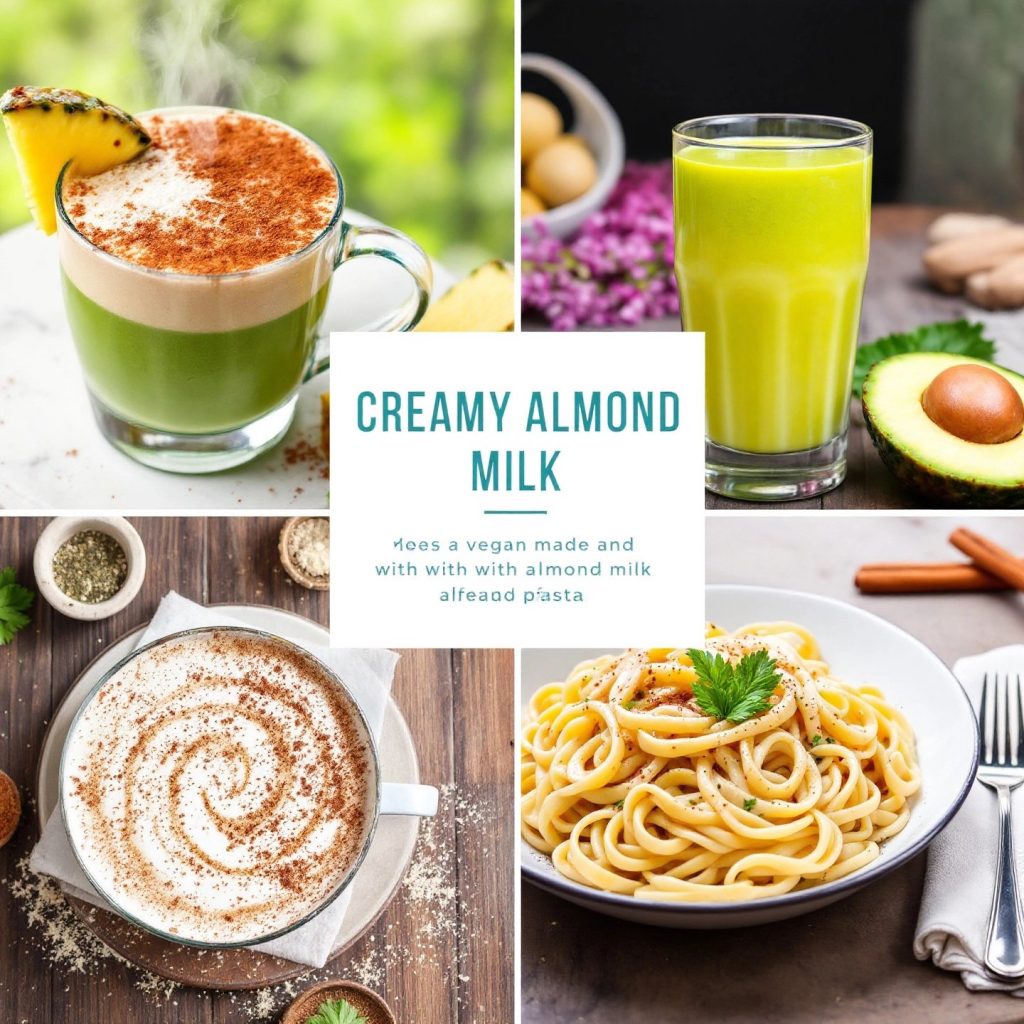Introduction to Creamy Almond Milk
Creamy almond milk has emerged as one of the most popular dairy alternatives, captivating the taste buds and dietary preferences of many. This nut-based beverage offers a delightful combination of lightness and richness, making it a favorite among those seeking plant-based options. Its creamy texture and subtle nutty flavor provide versatility, allowing it to be used in a wide array of recipes—from smoothies and lattes to baked goods and savory dishes. As a result, almond milk has become a staple in kitchens worldwide, especially for those who are lactose intolerant, vegan, or simply looking for a healthier alternative to traditional cow’s milk.
Part of the allure of creamy almond milk lies in its nutritional benefits. It is naturally low in calories and fat, yet it can be fortified with essential vitamins and minerals such as calcium, vitamin D, and vitamin E, making it a nutritious choice for many. The almond milk texture is what sets it apart, offering a satisfying mouthfeel that enhances the culinary experience. According to Statista, almond milk dominates the U.S. milk substitute market, with sales reaching nearly $1.3 billion annually, underscoring its widespread acceptance and demand.
This article aims to delve into the creamy world of almond milk, exploring its benefits, sharing delectable recipes, and offering insights into making it at home. Whether you’re a seasoned almond milk enthusiast or a curious newcomer, you’ll discover how this versatile beverage can enrich your diet and culinary repertoire. Join us on this journey to understand why creamy almond milk is more than just a trend—it’s a lifestyle choice that combines health, taste, and sustainability.

Illustration of the process of making creamy almond milk, highlighting key ingredients (AI-generated)
What Makes Almond Milk Creamy?
The luscious creaminess of almond milk is a result of several key factors, primarily the almond-to-water ratio, the quality of almonds used, and the inclusion of additional ingredients like thickeners or almond oil. Achieving the perfect creamy texture is both a science and an art, especially when crafting homemade almond milk.
The Almond-to-Water Ratio
One of the most significant determinants of creaminess is the almond-to-water ratio. For a thicker consistency, many homemade almond milk recipes suggest using two cups of almonds to three cups of water, as opposed to the more common one-to-four ratio. This increased concentration of almonds not only enhances the texture but also intensifies the nutty flavor, providing a richer taste experience (Tasting Table).
Quality of Almonds and Soaking Process
The quality of almonds plays a crucial role in the final texture of the milk. Fresh, high-quality almonds yield a smoother and creamier milk. Additionally, soaking almonds overnight, or for at least eight hours, softens them, making them easier to blend and resulting in a finer texture (The Raw Chef). This step is essential, as it helps to release the almonds’ natural oils, contributing to a creamier consistency.
Enhancing Creaminess with Additives
To further enhance the creaminess, some recipes incorporate natural thickeners or emulsifiers like lecithin. These ingredients help bind the water and almond oils, preventing separation and maintaining a uniform texture. Adding a small amount of almond oil can also enrich the milk’s creaminess, creating a velvety mouthfeel that rivals traditional dairy milk.
The Role of Homemade Recipes
While commercial brands often use stabilizers and thickeners to achieve a consistent creamy texture, homemade almond milk allows for personalization. By adjusting the almond-to-water ratio and experimenting with different additives, you can craft a milk that suits your taste and dietary preferences. This customization not only enhances the texture but also encourages a deeper understanding and appreciation of plant-based milk alternatives.
Understanding these factors can empower you to create a creamy almond milk recipe that is tailored to your liking, whether you prefer it in your morning coffee or as a base for a smoothie. As we explore further, we will compare various almond milk brands to see how they achieve their unique textures and flavors.
Comparing Creamy Almond Milk Brands
With the growing popularity of almond milk as a dairy alternative, a plethora of brands have emerged, each offering unique takes on this creamy beverage. When choosing the best creamy almond milk, factors such as texture, taste, and nutritional profile play a crucial role. Here, we explore some of the most popular brands and how they stack up against each other.
Texture and Taste: What to Expect
Texture is a defining characteristic of almond milk, and brands like Silk and Califia Farms have been noted for their exceptionally creamy offerings. Silk’s almond milk is often praised for its smooth, almost decadent mouthfeel, making it an excellent choice for those who enjoy their milk rich and velvety. Califia Farms, on the other hand, balances creaminess with a bold, nutty flavor, although some find it a bit too distinctive when mixed with other ingredients.
Trader Joe’s almond milk is another contender, known for its creamy texture that belies its thin appearance. This brand strikes a balance with a nutty flavor that’s well-suited for both drinking and culinary uses—perfect for those who prefer a more pronounced almond taste.
Nutritional Benefits Across Brands
Nutritional content can vary significantly between brands, especially in terms of added sugars and fortification with vitamins and minerals. Three Trees almond milk, praised for its purity, contains only almonds and water, offering a high-fat content that contributes to its creaminess. However, the simplicity comes at the cost of fewer added nutrients compared to fortified options.
Brands like Malk and Blue Diamond Almond Breeze offer fortified versions that include calcium and vitamin D, making them suitable for those looking to supplement their diet with essential nutrients. While Blue Diamond’s Almond Breeze is often criticized for being too thin, it remains a popular choice for its affordability and availability.
User Reviews and Market Ratings
User reviews highlight the importance of personal preference in choosing almond milk. According to reviews from Eat This, Not That, Malk and Three Trees are favored for their clean ingredient lists, though their higher price points can be a deterrent for some. Silk and Califia Farms are frequently mentioned for their balance of taste and texture, making them favorites among those who enjoy almond milk in its purest form.
Ultimately, the best creamy almond milk is subjective and depends on individual taste preferences and dietary needs. Whether you prioritize creaminess, nutritional content, or price, the array of options available ensures that there’s a perfect almond milk for everyone. As we continue, we’ll explore how to make your own creamy almond milk at home, offering a personalized alternative to store-bought varieties.

Step-by-step guide to making creamy almond milk at home (AI-generated)
How to Make Creamy Almond Milk at Home
Creating homemade creamy almond milk is a rewarding culinary endeavor that allows you to tailor the texture and flavor to your liking. With just a few simple ingredients and a bit of preparation, you can enjoy fresh almond milk that surpasses many store-bought options in both taste and nutritional value.
Choosing the Right Almonds
The foundation of any good almond milk is the almonds themselves. Opt for organic, raw almonds to avoid the added oils and salts found in roasted varieties. Raw almonds ensure a clean, pure flavor and a creamy consistency. Soaking the almonds is a crucial step, as it softens them and releases their natural oils, which is essential for achieving a rich, creamy texture. Ideally, soak the almonds overnight in the refrigerator for about 8 hours, but if you’re short on time, a quick soak in hot water for 1-2 hours can suffice (Downshiftology).
Perfecting the Almond-to-Water Ratio
The creaminess of your almond milk largely depends on the almond-to-water ratio. For a thicker, more luxurious milk, use two cups of almonds to three cups of water. This ratio enhances the milk’s body and flavor, making it ideal for drinking straight or using in recipes that benefit from a richer texture. For a lighter version, the standard one cup of almonds to four cups of water is recommended. Experimenting with these ratios allows you to find your perfect balance of creaminess and flavor (The Raw Chef).
Blending and Straining Techniques
Once your almonds are soaked and ready, blend them with water until smooth. A high-speed blender is ideal for this task as it ensures a finer blend and a creamier milk. After blending, strain the mixture through a nut milk bag or a fine mesh sieve to remove the almond pulp, leaving you with smooth, creamy milk. The leftover pulp can be dried and used in baking or as a topping for yogurt and cereal, adding a nutritious boost to your meals.
Customizing Flavor and Texture
One of the greatest advantages of making almond milk at home is the ability to customize it. Add a splash of vanilla extract, a pinch of sea salt, or a sweetener like honey or dates for a personalized touch. If you prefer an even creamier texture, incorporate a teaspoon of lecithin, which acts as an emulsifier and helps maintain the milk’s consistency. This flexibility not only enhances the flavor but also ensures that your almond milk meets your dietary preferences and culinary needs.
You can read this article to learn more about: how to make creamy almond milk at home
By mastering these almond milk making tips, you unlock the potential to create a creamy, delicious beverage that can be enjoyed on its own or as a versatile ingredient in various recipes. As we continue, let’s delve into the nutritional benefits of almond milk and how it compares to other plant-based alternatives.
Nutritional Benefits of Creamy Almond Milk
Creamy almond milk stands out not only for its delightful texture but also for its impressive nutritional profile, making it a popular choice among health-conscious consumers. This plant-based milk is naturally dairy-free, making it an excellent alternative for those with lactose intolerance or dairy allergies. Moreover, it is low in calories, with unsweetened versions containing only about 30 to 60 calories per cup, depending on the brand. This makes almond milk an ideal option for those looking to manage their calorie intake while still enjoying a creamy beverage.
Rich in Essential Vitamins and Minerals
One of the key nutritional benefits of almond milk is its fortification with essential vitamins and minerals. Most commercial almond milks are enriched with calcium, vitamin D, and vitamin E, nutrients that are vital for bone health, immune function, and skin health respectively. Vitamin E, a powerful antioxidant, helps combat oxidative stress and supports overall well-being. Additionally, the presence of vitamin D enhances calcium absorption, promoting strong bones and teeth.
Comparing Almond Milk to Other Plant-Based Milks
When it comes to comparing almond milk to other plant-based milks, such as soy, rice, and coconut milk, each has its unique nutritional offerings. Almond milk is typically lower in protein compared to soy milk, which provides about 7 grams of protein per cup, while almond milk offers just 1 gram. However, almond milk is often preferred for its lower calorie content and absence of saturated fats. Rice milk, although higher in carbohydrates, is also low in protein and fat, making almond milk a more balanced option for those seeking a low-calorie drink.
For individuals with nut allergies, soy and rice milk serve as viable alternatives, though almond milk’s creamy texture and nutty flavor remain unmatched. Coconut milk, while creamy, tends to be higher in fat and calories, which might not align with everyone’s dietary goals. Thus, almond milk strikes a harmonious balance between taste, texture, and nutrition, making it a versatile choice in the realm of plant-based beverages (Healthline).
Encouraging Homemade Plant-Based Milk
For those interested in maximizing the nutritional benefits of almond milk, making it at home can be an enticing option. Homemade almond milk allows for complete control over ingredients and fortification, ensuring a purer product without additives or preservatives. This not only enhances the nutritional profile but also offers an opportunity to experiment with flavors and textures, encouraging a more sustainable and personalized plant-based lifestyle.
As we continue, let’s explore how creamy almond milk can be integrated into various delicious recipes, enhancing both sweet and savory dishes with its unique flavor and texture.

Variety of dishes made with creamy almond milk, showcasing its versatility (AI-generated)
Delicious Recipes Using Creamy Almond Milk
Creamy almond milk’s versatility extends far beyond being a simple dairy alternative. Its rich texture and subtle nutty flavor make it an excellent ingredient in a variety of recipes, from refreshing smoothies to indulgent desserts. Here, we explore some creative and delectable almond milk recipes that highlight its flexibility in both sweet and savory dishes.
Smoothies and Beverages
One of the simplest ways to enjoy creamy almond milk is by incorporating it into smoothies. For a refreshing morning boost, blend almond milk with a handful of spinach, a ripe banana, and a scoop of protein powder. Add a dash of cinnamon for an extra kick. This green smoothie is not only nutritious but also incredibly satisfying.
For a cozy treat, try an almond milk latte. Heat almond milk with a cinnamon stick and a splash of vanilla extract, then froth it using a milk frother or whisk. Pour over freshly brewed espresso or strong coffee for a comforting beverage that rivals your favorite café’s offerings (Pacific Foods).
Savory Dishes
Creamy almond milk can also be a fantastic addition to savory recipes. Consider using it in a vegan Alfredo sauce for pasta. Start by sautéing minced garlic in olive oil, then stir in almond milk and nutritional yeast for a cheesy flavor. Toss with cooked pasta and steamed broccoli for a hearty and healthy meal.
Another savory option is almond milk-based soups. A creamy tomato basil soup made with almond milk provides a dairy-free twist on a classic. Simmer tomatoes, garlic, and fresh basil, then blend with almond milk for a smooth, comforting soup that pairs perfectly with crusty bread.
Desserts and Baked Goods
Almond milk’s creamy texture is ideal for desserts. Try making a chocolate almond pudding by whisking together almond milk, cocoa powder, and cornstarch until thickened. Sweeten with maple syrup and chill for a rich, chocolatey treat.
For baking, almond milk can be used in place of dairy milk in recipes for muffins, cakes, and pancakes. Its subtle flavor complements ingredients like vanilla and almond extract, enhancing the overall taste of your baked goods. For a delightful breakfast, try almond milk pancakes topped with fresh berries and a drizzle of honey.
These almond milk recipes not only showcase the ingredient’s versatility but also encourage creativity in the kitchen. By experimenting with creamy almond milk, you can enjoy a variety of delicious dishes that cater to both dietary preferences and culinary ambitions. As you explore these recipes, consider making your own almond milk at home to further customize flavors and textures, enhancing your plant-based culinary adventures.
Conclusion: Embracing Creamy Almond Milk in Your Diet
Creamy almond milk offers a delightful blend of taste, texture, and nutrition, making it a versatile addition to any diet. Its appeal lies not only in its rich, nutty flavor but also in its ability to serve as a nutritious alternative to traditional dairy milk. With its low-calorie content and fortification options, almond milk supports a healthy lifestyle, making it an ideal choice for those on an almond milk diet or anyone seeking to enhance their almond milk lifestyle. Whether you’re lactose intolerant, vegan, or simply looking to diversify your nutritional intake, almond milk provides a satisfying solution.
Incorporating creamy almond milk into your daily routine can be as simple as adding it to your morning coffee, blending it into smoothies, or using it as a base for soups and sauces. Its versatility extends to both sweet and savory dishes, offering endless possibilities for culinary creativity. Moreover, the ease of making homemade almond milk allows you to tailor the flavor and texture to your liking, ensuring a fresh and personalized experience every time.
For those interested in exploring the world of plant-based beverages further, consider experimenting with different almond milk brands to find the one that best suits your taste and dietary needs. Alternatively, making your own almond milk at home can be a rewarding endeavor, offering complete control over ingredients and allowing for customization that aligns with your health goals. To start your journey into homemade plant-based milk, check out our guide on the best plant milk makers of 2025, which provides insights into the most convenient and eco-friendly options available.
Ultimately, embracing creamy almond milk in your diet is not just about enjoying a delicious beverage; it’s about adopting a lifestyle that values health, sustainability, and culinary exploration. As you incorporate almond milk into your meals, you’ll discover its ability to enhance both flavor and nutrition, making it a staple in your kitchen and a key component of a balanced diet.
Frequently Asked Questions about Creamy Almond Milk
1. Is there a creamy almond milk?
Yes, many brands offer creamy almond milk, often enhanced by adding almond oil or thickeners. Homemade versions can also be tailored for creaminess by adjusting the almond-to-water ratio.
2. How do you make almond milk creamier?
To make almond milk creamier, use a higher almond-to-water ratio, such as two cups of almonds to three cups of water. Soaking almonds longer and adding natural thickeners can also help.
3. What makes almond milk creamy?
The creaminess of almond milk is influenced by the almond-to-water ratio, quality of almonds, and whether thickeners or almond oil are added. Homemade recipes offer customization for texture.
4. How does almond milk compare nutritionally to other plant-based milks?
Almond milk is low in calories and often fortified with vitamins like calcium and vitamin D. It has less protein than soy milk but is lower in calories and fats compared to coconut milk.
5. Can you use almond milk in savory dishes?
Yes, almond milk’s creamy texture makes it ideal for savory dishes like vegan Alfredo sauce or tomato basil soup, adding richness without dairy.
